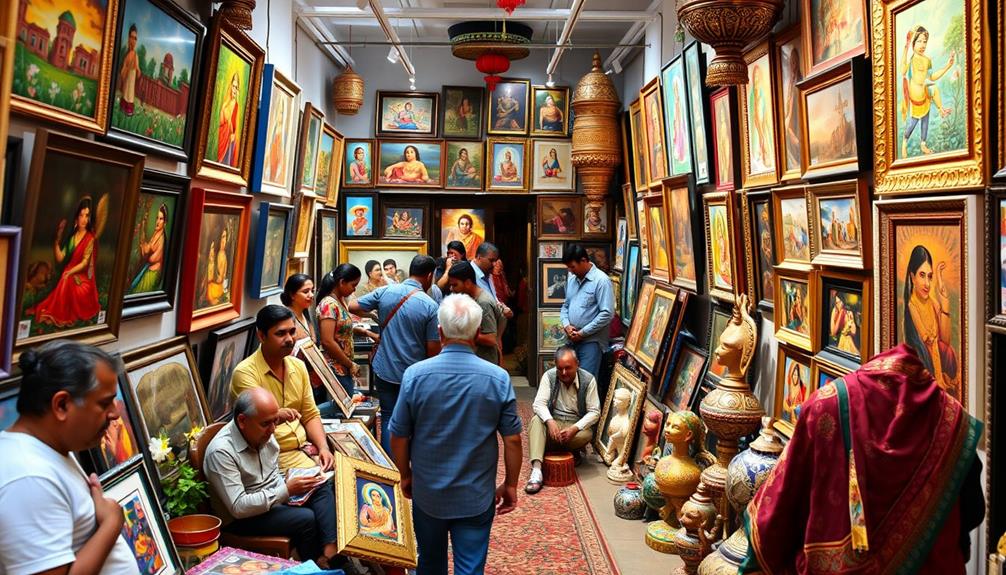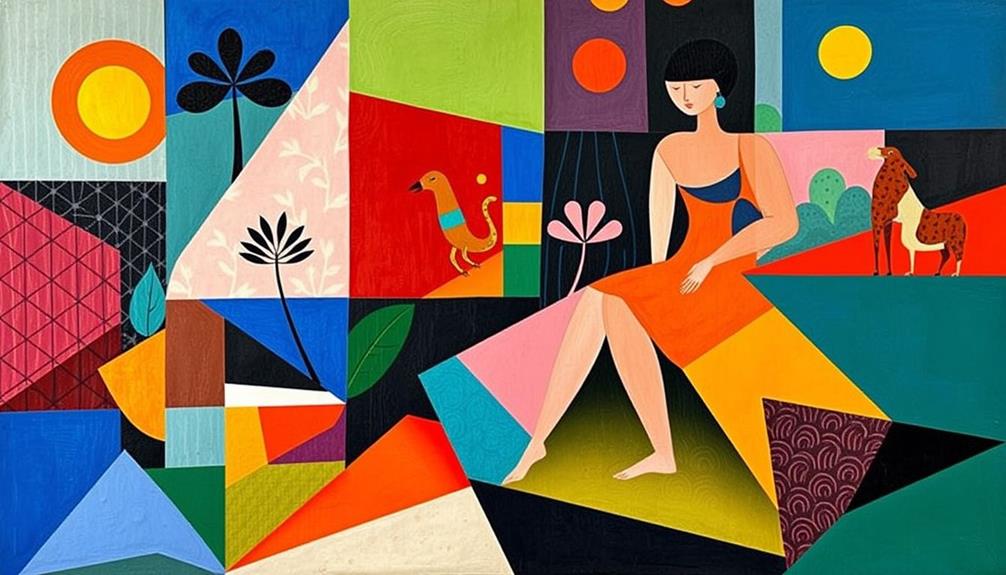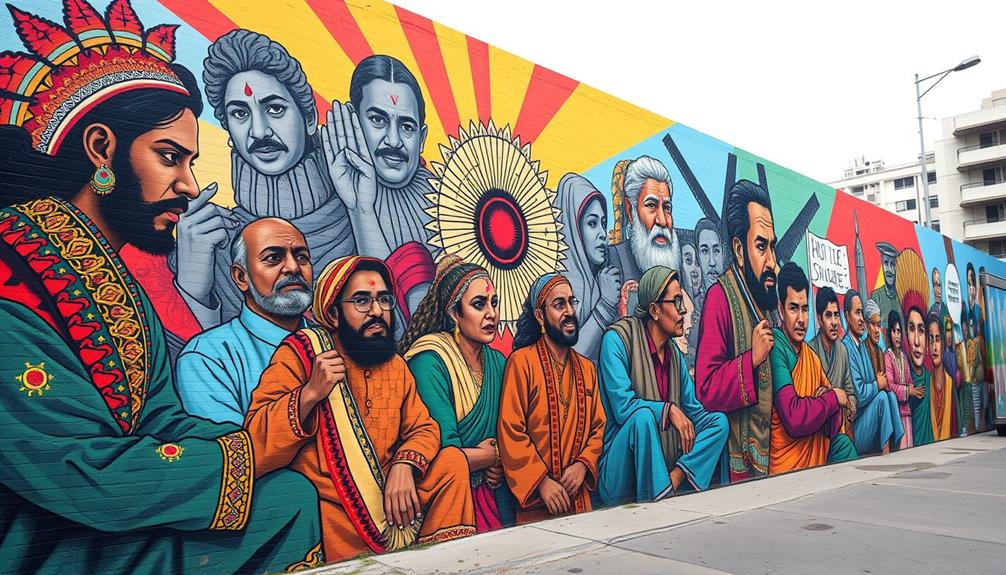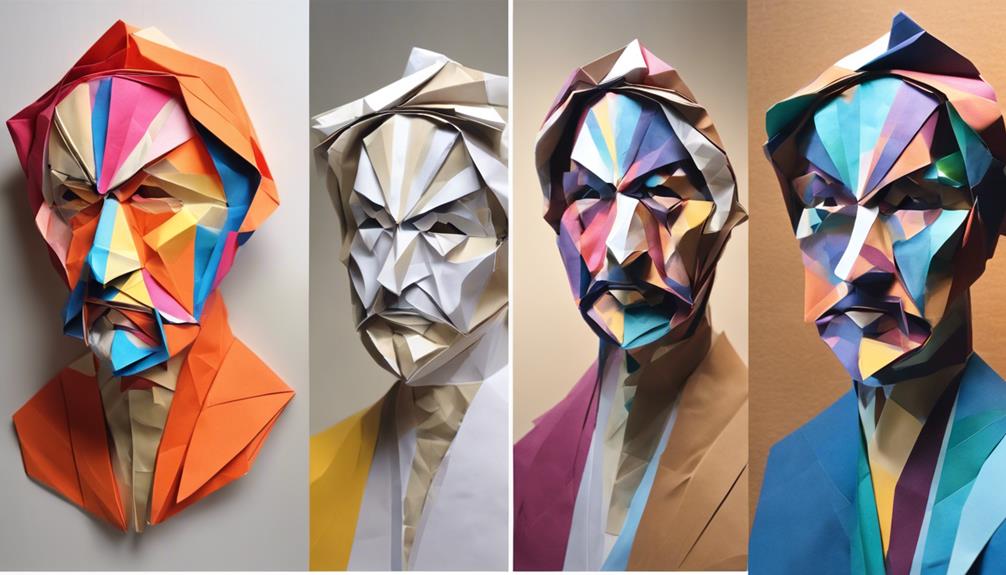You'll find that the Pata painting tradition of Odisha is a vibrant art form with roots stretching back over 2,000 years. Created by the Chitrakar community, these scrolls vividly depict mythological stories and social issues. The influence of Pata painting seeps into Bengali art, where traditional themes blend with local folklore and contemporary techniques. Key artists adapt these styles to address modern challenges, ensuring their relevance. This cultural exchange enriches both regions' artistic landscapes. If you're curious about how these traditions continue evolving, there's much more to uncover about their dynamic relationship and ongoing impact.
Key Takeaways
- Pata painting, originating from Odisha, has a rich history of over 2,000 years, depicting mythological narratives and moral lessons.
- Key artists like Swarno Chitrakar and Ramesh Chitrakar address contemporary issues through Patachitra, ensuring its relevance and sustainability.
- Regional variants, such as Bengal Patachitra, incorporate local folklore, blending traditional Pata styles with modern influences and techniques.
- The collaborative exchange between Odisha and Bengal fosters cultural dialogue, enriching both artistic traditions with shared techniques and natural materials.
- Contemporary challenges, including declining patronage, threaten the survival of Pata painting, urging a need for renewed interest and support.
Historical Overview of Pata Painting
Exploring the rich history of Pata painting reveals its origins in Odisha, dating back over 2,000 years. This traditional folk art is deeply intertwined with the Chitrakar community, where artists known as "patuas" created intricate scrolls that depicted mythological narratives and moral lessons.
These scrolls served as visual aids for storytelling traditions, enchanting audiences with their vibrant colors and detailed imagery. Much like the emphasis on natural materials in modern farmhouse decor trends, Pata painting utilizes vivid colors derived from natural sources, showcasing the connection between art and nature.
During the 20th century, Pata painting gained prominence, particularly through its association with the Jagannath temple at Puri, highlighting themes centered on Hindu deities.
As you dive deeper into its evolution, you'll notice the impact of the colonial period, which birthed the Kalighat genre. This new style merged Western artistic influences with traditional techniques, often incorporating satirical elements to comment on social and political issues.
Today, Pata painting continues to thrive, adapting to incorporate contemporary themes while honoring its rich heritage.
Artists are now exploring modern subjects, ensuring that this ancient art form remains relevant. By understanding its historical roots, you can appreciate how Pata painting reflects both cultural identity and the dynamic nature of artistic expression.
Key Artists and Their Contributions

When you explore the key artists in the Patachitra tradition, you'll discover how they innovate techniques and address pressing social themes.
This approach to art resonates with the principles of design thinking, emphasizing empathy and creativity.
Artists like Swarno Chitrakar and Bahar Chitrakar not only preserve regional narratives but also challenge societal issues through their work.
Their contributions highlight the dynamic nature of this art form and its ability to reflect contemporary concerns.
Notable Patachitra Practitioners
The Patachitra tradition of Odisha thrives thanks to the remarkable contributions of several key artists who bring this vibrant art form to life. Swarno Chitrakar, hailing from Naya village, is a prominent Patua artist who addresses pressing social issues through his vivid narratives. His works tackle topics like female infanticide and trafficking, blending artistry with advocacy.
Understanding the importance of dog nutrition can also inspire artists to explore themes related to animal welfare in their works.
Bahar Chitrakar focuses on political Patachitra, illustrating local folklore and historical events. His art preserves and disseminates cultural heritage, making it accessible to a wider audience.
Meanwhile, the Chitrakar community plays a significant role in keeping the Patachitra tradition alive. Artisans like Ramesh Chitrakar adapt the art form to contemporary themes, guaranteeing its relevance in today's world.
Artists like Jitendra Chitrakar embrace modern techniques and materials while staying true to traditional motifs, allowing Patachitra to evolve into a popular medium for decorative arts and merchandise.
Increased recognition through awards and exhibitions has enhanced the visibility of these artists, contributing to the economic sustainability of the handicrafts industry in Odisha and West Bengal. Their efforts ensure that Patachitra continues to flourish, bridging the gap between tradition and modernity.
Innovative Artistic Techniques
Innovative artistic techniques in Patachitra have transformed the way this traditional art form is practiced today. Key artists like Swarno Chitrakar from Naya village are using Patachitra painting to tackle pressing social issues such as female infanticide and trafficking. By adapting traditional narratives to contemporary concerns, they bring relevance to this ancient art.
Furthermore, the psychological impact of art on self-perception may enhance the effectiveness of these messages, fostering deeper connections with audiences astrology claims to influence personality traits linked to attractiveness.
Bahar Chitrakar, on the other hand, incorporates political history and local folklore, showcasing Patachitra's role in documenting socio-political changes in society.
Contemporary Patachitra artists are also expanding their mediums beyond traditional scrolls, creating unique objects like coasters, kettles, and clothing. This blend of traditional techniques with modern aesthetics is redefining the art form.
In addition, the use of natural colors derived from minerals and plants remains a hallmark, with artists preparing their own pigments to guarantee authenticity.
The evolution of storytelling in Patachitra reflects influences from Indian cinema, leading to more condensed narratives and innovative approaches in both themes and formats.
These developments not only preserve the essence of Patachitra but also maintain its continued relevance and appeal in today's world.
Social Themes in Art
Patachitra artists are increasingly using their craft to spotlight notable social issues, transforming how art interacts with contemporary life.
Take Swarno Chitrakar, for instance; this prominent Patua artist from Naya village harnesses the power of Patachitra painting to address pressing topics like female infanticide and trafficking, reflecting a deep connection between art and astrology and attractiveness that can influence societal perceptions. By doing so, he effectively raises awareness through his art of storytelling.
Then there's Bahar Chitrakar, who blends traditional painting techniques with political narratives, weaving local folklore and historical events into his Patachitra. His work helps preserve community identity while simultaneously confronting contemporary themes.
The Patachitra tradition in Naya village, home to around 100 Patua families, has evolved notably. Artists like Manas Kumar Chitrakar now integrate modern themes, such as environmental concerns and women's rights, showcasing the adaptability of this art form to current socio-political contexts.
The recognition and awards received by Patuas not only enhance their visibility but also encourage a focus on social themes in their artwork.
This evolution fosters a dialogue between tradition and modernity, ensuring that Patachitra remains relevant in today's world.
Techniques and Materials in Patachitra

When you explore Patachitra, you'll notice that artists rely on natural colors made from minerals and plants, which give each piece its unique vibrancy.
Recent studies indicate the significance of using traditional methods to preserve cultural heritage, similar to how weight loss strategies are emphasized in various trekking practices.
They use traditional techniques, like sketching directly onto the canvas and layering colors, to create depth and detail.
This meticulous process not only highlights their skill but also connects the art to its cultural roots.
Natural Color Preparation
Utilizing natural materials, Patachitra artists create vibrant colors that reflect their rich cultural heritage.
Curiously, the emotional responses evoked by these artworks can be profound, similar to how cats exhibit signs of attachment to their owners.
By employing a variety of traditional practices, they guarantee that each artwork isn't only beautiful but also eco-friendly.
Here are some essential elements involved in the preparation of natural colors:
- Pigments: Artists use minerals and plants to create pigments like Hingula (vermilion), Haritala (green), and Kala (black).
- Canvas Preparation: The canvas is made from a mixture of chalk and tamarind gum, resulting in a leathery finish that enhances paint adherence and longevity.
- Brushes: Traditional brushes crafted from natural materials like hair and palm leaves allow for fine detailing in the intricate designs characteristic of Patachitra.
- Layering Technique: Artists apply multiple coats of natural pigments to achieve depth and vibrancy, enhancing the visual impact of their eco-friendly artworks.
Traditional Painting Techniques
The intricate beauty of Patachitra relies heavily on the traditional painting techniques and materials employed by skilled chitrakars. You'll notice that the chitrakars prepare their canvas using a mixture of chalk and gum, achieving a leathery finish that enhances their artwork.
The painting process begins with meticulous sketching directly onto the canvas, followed by filling in vibrant colors using a layering technique. This method not only enriches the colors but also adds depth to the intricate designs, similar to how energy-efficient appliances contribute to a sustainable lifestyle in tiny homes.
The natural pigments, such as Hingula (Vermilion), Haritala (Green), and Geru (Brick Orange), are prepared by the artists themselves, allowing them to maintain traditional practices. They craft their brushes from natural materials like hair and palm leaves, enabling fine detailing vital for the intricate patterns characteristic of Patachitra.
Once completed, the final artwork is often coated with lacquer, which provides weather protection and glossiness. This significant step guarantees durability while preserving the vivid colors, allowing the beauty of Patachitra to shine through for generations.
Themes Explored in Pata Art
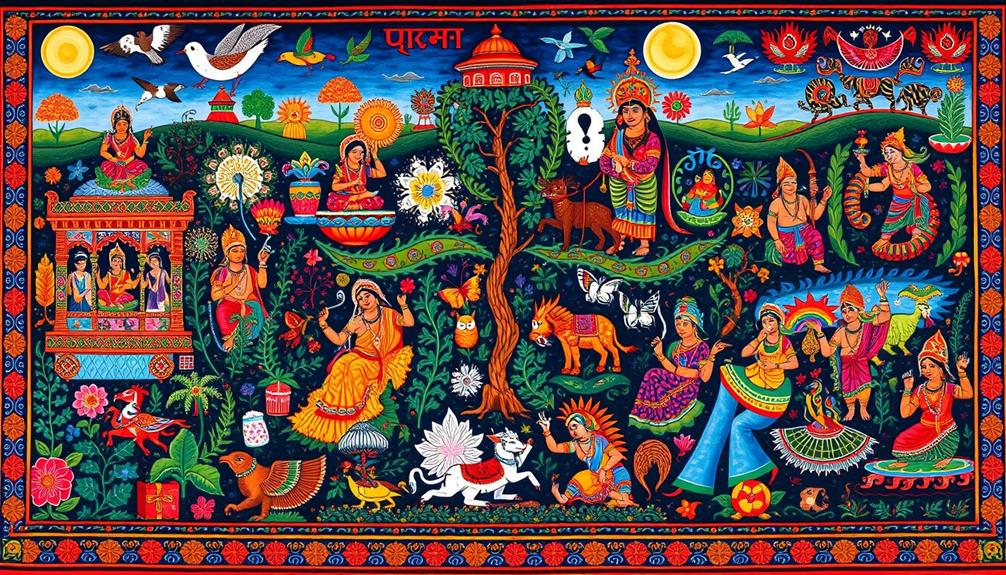
Pata art captivates viewers with its rich exploration of themes deeply rooted in both mythology and contemporary social issues. This unique form of Pattachitra painting often combines the vibrant spirit of traditional narratives with pressing concerns of modern society.
The emotional depth and complexity in these artworks can be likened to the dynamics found in narcissistic relationships, where the interplay of admiration and devaluation creates a rich tapestry of human experience. Here are some key themes you'll encounter:
- Hindu Mythology: Depictions of deities like Lord Jagannath and stories of Radha and Krishna are common, connecting you to the spiritual heritage of Odisha and Bengal.
- Social Issues: Contemporary Pata art addresses serious topics, such as female infanticide and human trafficking, allowing you to reflect on societal challenges.
- Environmental Concerns: Modern themes also include ecological issues, emphasizing the need for awareness and action.
- Political Commentary: Some artists use their work to critique political situations, merging art with activism.
Bold colors and intricate designs enhance the visual appeal of these themes. Natural pigments derived from local minerals and plants infuse life into the artwork, while layered techniques add depth and vibrancy.
Such themes guarantee that Pata art remains not only a storytelling medium but also a powerful voice for change.
Regional Variants of Pata Painting

Regional variations of Pata painting showcase a rich tapestry of artistic expression, each unique yet interconnected through shared cultural themes. In Odisha, you'll find the vibrant Odisha Pattachitra, known for its bold colors and intricate details that often depict divine figures and mythical creatures from Hindu mythology. The canvas is crafted using natural pigments, stone powder, and tamarind gum, creating a stunning visual experience.
These practices resonate with the cultural significance seen in Aboriginal rock art, highlighting the importance of preserving historical narratives through art.
Moving to Bengal, the Bengal Patachitra utilizes handmade paper with fabric backing, focusing on similar themes of Hindu mythology and local folklore. Artists like Jamini Roy have introduced modern influences and social commentary, enriching this folk art form.
Kalighat Pattachitra emerged during the British Raj, fusing traditional elements with contemporary views, showcasing urban life through dynamic brushstrokes.
Additionally, Tala Pattachitra crafted on dried palm leaves highlights local folklore and tribal life, while Santhal Pattachitra emphasizes the Santhal tribe's relationship with nature through bold geometric patterns.
Together, these regional variants of scroll painting reflect diverse cultural narratives that resonate across Odisha and Bengal, demonstrating the beauty and depth of this timeless art form.
Cultural Significance in Odisha
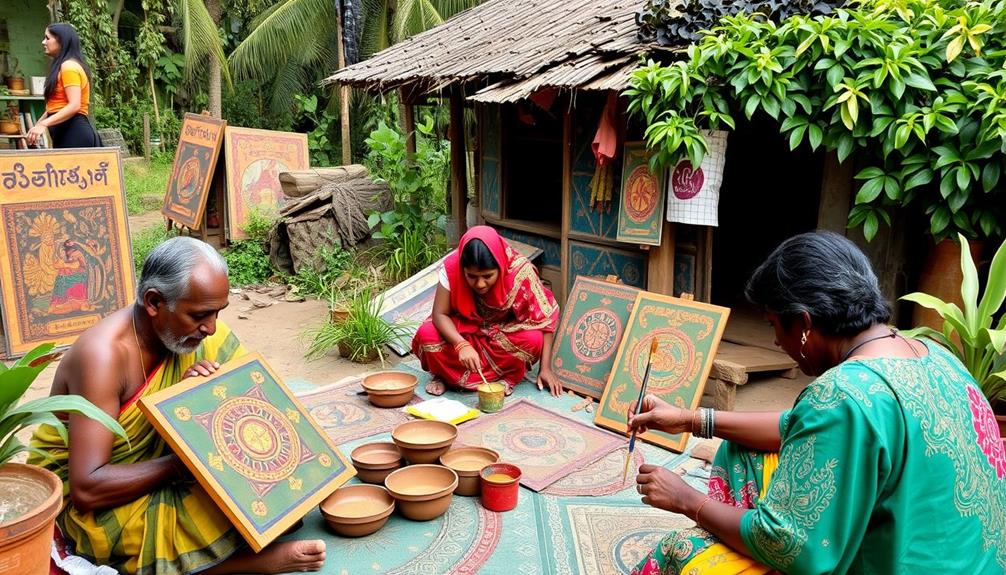
In Odisha, Pata painting holds immense cultural significance, acting as a vibrant visual narrative that brings Hindu mythology and local folklore to life. This art form, particularly associated with the Jagannath temple at Puri, serves multiple purposes:
- Storytelling: Pattachitra artists, known as Chitrakars, weave tales of deities like Lord Jagannath and Radha-Krishna through intricate details.
- Social Commentary: These paintings often reflect contemporary issues, like women's rights and environmental concerns, making them relevant in today's context.
- Cultural Preservation: Each scroll is a repository of cultural narratives, preserving the rich traditions of Odisha for future generations.
- Community Engagement: Chitrakars act as itinerant storytellers, showcasing their art during village gatherings and festivals, fostering a sense of community.
The use of natural pigments derived from minerals and plants enhances the vibrant colors, ensuring that each piece resonates with cultural richness.
While its roots are deep in Odisha, the Pattachitra tradition has also left a mark across Bengal, influencing various art forms, illustrating its adaptive nature and robust cultural heritage.
Influence on Bengali Artistic Traditions

There's no denying that the Pata painting tradition from Odisha has left a profound impact on Bengali artistic expressions. As a Bengali artist, you might notice how the intricate narratives and vibrant colors of Pattachitra have influenced your own work.
The Patuas, traditional Bengali painters, embraced these styles, blending them with local folklore to create a unique regional variant that resonates with cultural narratives from Bengal.
During the British Raj, you may have observed the evolution of Kalighat Pattachitra, where artists incorporated Western influences while maintaining the essence of Odisha's Pata elements. This fusion led to satirical representations that reflected social and political themes relevant to the times.
Collaborations between artists from Odisha and Bengal have nurtured a rich exchange of techniques and themes, enhancing your artistic practices and fostering cultural dialogue.
Additionally, the shared commitment to using natural pigments and traditional materials underscores a common heritage, emphasizing the importance of preserving these indigenous artistic methods.
As you explore your own artistic journey, the influence of Odisha's Pata painting tradition continues to inspire and shape the vibrant world of Bengali folk art.
Contemporary Challenges and Adaptations

The Pata painting tradition now faces significant contemporary challenges, particularly declining patronage and the pressures of modernization. As the world evolves, many artists find themselves exploring alternative occupations, which threatens the continuity of this rich art form.
Here are some key challenges:
- Declining Patronage: Fewer collectors and patrons support traditional artisans.
- Competition from Modern Media: The rise of smartphones and the internet distracts audiences from traditional storytelling methods.
- Evolving Themes: Artists are now incorporating contemporary themes like women's rights and environmental issues, but this may alienate traditionalists.
- Global Adaptations: While Pattachitra gains global reach by integrating into modern decor and fashion, it risks losing its essence.
To counter these challenges, various organizations and preservation initiatives are stepping in. They promote awareness through workshops and exhibitions, aiming to support local artisans.
By embracing contemporary themes and adapting to modern aesthetics, Pattachitra artists endeavor to stay relevant. However, the balance between tradition and innovation is delicate.
What remains vital is the continued support from the community to guarantee that this vibrant art form not only survives but thrives in the modern world.
Preservation Efforts and Future Directions

Numerous preservation efforts are underway to guarantee the Pata painting tradition not only survives but flourishes in the modern era. Organizations like the Daricha Foundation are hosting workshops and exhibitions to raise awareness and appreciation of this vibrant art form. Government initiatives in regions like Naya village are providing essential support, ensuring sustainable growth for Pata painting practices.
UNESCO's involvement has introduced training and resources that help artisans adapt to contemporary market demands while preserving traditional techniques. In addition, documentation and research projects are significant for safeguarding the cultural heritage associated with Pata painting, ensuring that knowledge is passed down to future generations.
Increased collaboration between traditional artists and modern designers is fostering innovative adaptations of Pata painting, keeping it relevant in today's art and commerce landscape.
Here's a summary of key preservation efforts:
| Efforts | Details |
|---|---|
| Workshops and Exhibitions | Increase awareness and appreciation of Pata painting. |
| Government Support | Investments aid sustainability in regions like Naya. |
| UNESCO's Training | Helps artisans balance tradition with contemporary needs. |
| Collaborative Projects | Merges traditional techniques with modern designs. |
These initiatives pave the way for a vibrant future for Pata painting.
Frequently Asked Questions
What Is the Traditional Painting of Odisha?
The traditional painting of Odisha, known as Pattachitra, features intricate details and vibrant colors. It often depicts mythological themes from Hindu epics, showcasing the deep cultural identity and heritage of the region.
What Is the Importance of the Pattachitra Painting?
Like a vibrant tapestry, Pattachitra paintings weave together storytelling, cultural heritage, and economic opportunity. You'll see how they preserve traditions, support artisans, and enrich community identity, making them essential to both art and society.
What Is the Difference Between Bengal Pattachitra and Odisha Pattachitra?
Bengal Pattachitra uses handmade paper and vibrant earth pigments, focusing on local stories, while Odisha Pattachitra features cloth, natural colors, and divine themes. You'll notice bold patterns in Bengal versus intricate details in Odisha's work.
Which Painter Influenced Patachitra?
Jamini Roy considerably influenced Patachitra by merging traditional themes with contemporary social commentary. His innovative approach bridged folk and modern styles, inspiring other artists to adapt and evolve the art form in meaningful ways.
Conclusion
In exploring the vibrant world of Pata painting, you uncover its rich history, embrace its intricate techniques, and appreciate its profound themes. As you witness its influence on Bengali art, you recognize the cultural connections that bind these traditions together. You also see the challenges artists face and the efforts made to preserve this heritage for future generations. By engaging with Patachitra, you not only celebrate its beauty but also contribute to its enduring legacy.

